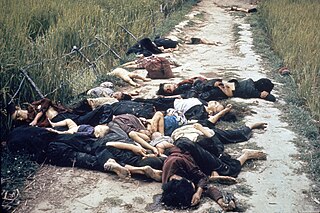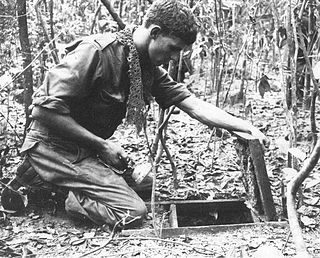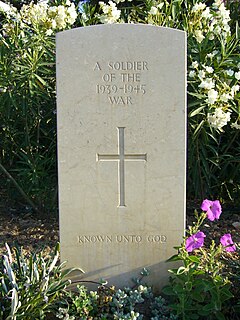
A hooch maid was a South Vietnamese woman employed to clean the shelters and keep house for American servicemen during the Vietnam War. [1]

A hooch maid was a South Vietnamese woman employed to clean the shelters and keep house for American servicemen during the Vietnam War. [1]
American soldiers in South Vietnam sometimes called the dwellings of Vietnamese civilians "hooches" (possibly a borrowing from Japanese 家 uchi, "dwelling"). [2] [3] Thus, the Vietnamese civilian women who maintained the dwellings were called "hooch maids". These women typically worked six days a week, cleaning and maintaining the rooms and belongings of the soldiers. If their work quality was deemed to be sufficient, they could be given goods from the base exchange, which could be turned into extra income on the black market. [4] [ self-published source? ]
The military generally allowed most officers and non-commissioned men to have hooch maids, whenever these men wanted and requested their services. In Da Nang, military trucks picked up the maids at designated stops in the city every morning, and returned them in the evening. Issues often arose between the soldiers and the maids, due to cultural differences, including how to clean clothes properly, and how much soap to use when washing the clothes. [5] Maids also cooked for the men when appropriate. [6]
The maids could earn as much as a captain in the South Vietnamese Army, although it was often less. [7] One soldier described the maids as being "...good Catholics who might flirt with you but would never date an American soldier." [1] Nonetheless, some maids reportedly had sex with soldiers to earn extra income. [8]

The Vietnam War, also known as the Second Indochina War, and in Vietnam as the Resistance War Against America or simply the American War, was a conflict in Vietnam, Laos, and Cambodia from 1 November 1955 to the fall of Saigon on 30 April 1975. It was the second of the Indochina Wars and was officially fought between North Vietnam and South Vietnam. North Vietnam was supported by the Soviet Union, China, and other communist allies; South Vietnam was supported by the United States, South Korea, the Philippines, Australia, Thailand and other anti-communist allies. The war, considered a Cold War-era proxy war by some, lasted 19 years, with direct U.S. involvement ending in 1973, and included the Laotian Civil War and the Cambodian Civil War, which ended with all three countries becoming communist in 1975.

The Việt Cộng, also known as the National Liberation Front of South Vietnam or FNL, was a mass political organization in South Vietnam and Cambodia with its own army – the Liberation Army of South Vietnam (LASV) – that fought against the United States and South Vietnamese governments during the Vietnam War, eventually emerging on the winning side. It had both guerrilla and regular army units, as well as a network of cadres who organized peasants in the territory it controlled. Many soldiers were recruited in South Vietnam, but others were attached to the People's Army of Vietnam (PAVN), the regular North Vietnamese army. During the war, communists and anti-war activists insisted the Việt Cộng was an insurgency indigenous to the South, while the U.S. and South Vietnamese governments portrayed the group as a tool of Hanoi. Although the terminology distinguishes northerners from the southerners, communist forces were under a single command structure set up in 1958.

The Mỹ Lai Massacre was the Vietnam War mass murder of unarmed South Vietnamese civilians by U.S. troops in Sơn Tịnh District, South Vietnam, on 16 March 1968. Between 347 and 504 unarmed people were killed by U.S. Army soldiers from Company C, 1st Battalion, 20th Infantry Regiment and Company B, 4th Battalion, 3rd Infantry Regiment, 11th Brigade, 23rd (Americal) Infantry Division. Victims included men, women, children, and infants. Some of the women were gang-raped and their bodies mutilated as were children as young as 12. Twenty-six soldiers were charged with criminal offenses, but only Lieutenant William Calley Jr., a platoon leader in C Company, was convicted. Found guilty of killing 22 villagers, he was originally given a life sentence, but served only three and a half years under house arrest.
William Laws Calley Jr. is an American war criminal and a former United States Army officer convicted by court-martial of murdering 22 unarmed South Vietnamese civilians in the My Lai Massacre on March 16, 1968, during the Vietnam War. Calley was released to house arrest under orders by President Richard Nixon three days after his conviction. Following a petition for habeas corpus by Calley, a new trial was ordered by the 5th Circuit Federal court in Georgia. That ruling however was overturned on an appeal and the Supreme Court denied certiorari. His initial conviction faced widespread public opposition, both due to the campaign circumstances of civilian embedded Viet Cong and also due to Calley being singled out as the sole officer convicted with respect to the massacre.

William Childs Westmoreland was a United States Army General, most notably commander of United States forces during the Vietnam War from 1964 to 1968. He served as Chief of Staff of the United States Army from 1968 to 1972.

The Tet Offensive, or officially called The General Offensive and Uprising of Tet Mau Than 1968 was one of the largest military campaigns of the Vietnam War, launched on January 30, 1968 by forces of the Viet Cong (VC) and North Vietnamese People's Army of Vietnam (PAVN) against the forces of the South Vietnamese Army of the Republic of Vietnam (ARVN), the United States Armed Forces and their allies. It was a campaign of surprise attacks against military and civilian command and control centers throughout South Vietnam. The name of the offensive comes from the Tết holiday, the Vietnamese New Year, when the first major attacks took place.

The First Indochina War began in French Indochina on December 19, 1946, and lasted until July 20, 1954. Fighting between French forces and their Việt Minh opponents in the south dated from September 1945. The conflict pitted a range of forces, including the French Union's French Far East Expeditionary Corps, led by France and supported by Bảo Đại's Vietnamese National Army against the Việt Minh, led by Hồ Chí Minh and the People's Army of Vietnam led by Võ Nguyên Giáp. Most of the fighting took place in Tonkin in northern Vietnam, although the conflict engulfed the entire country and also extended into the neighboring French Indochina protectorates of Laos and Cambodia.

The tunnel rats were American, South Vietnamese, New Zealand, and Australian soldiers who performed underground search and destroy missions during the Vietnam War.

Major General Nguyễn Ngọc Loan was a South Vietnamese general and chief of the South Vietnamese National Police.

Missing in action (MIA) is a casualty classification assigned to combatants, military chaplains, combat medics, and prisoners of war who are reported missing during wartime or ceasefire. They may have been killed, wounded, captured, or deserted. If deceased, neither their remains nor grave has been positively identified. Becoming MIA has been an occupational risk for as long as there has been warfare.
The Huế Massacre is the name given to the summary executions and mass killings perpetrated by the Việt Cộng (VC) and People's Army of Vietnam (PAVN) during their capture, occupation and later withdrawal from the city of Huế during the Tết Offensive, considered one of the longest and bloodiest battles of the Vietnam War.

The Paris Peace Accords, officially titled the Agreement on Ending the War and Restoring Peace in Viet Nam, was a peace treaty signed on January 27, 1973, to establish peace in Vietnam and end the Vietnam War. The treaty included the governments of the Democratic Republic of Vietnam, the Republic of Vietnam, and the United States, as well as the Republic of South Vietnam (PRG) that represented indigenous South Vietnamese revolutionaries. US ground forces up to that point had been sidelined with deteriorating morale and gradually withdrawn to coastal regions, not partaking in offensive operations or much direct combat for the preceding two-year period. The Paris Agreement Treaty would in effect remove all remaining US Forces, including air and naval forces in exchange. Direct U.S. military intervention was ended, and fighting between the three remaining powers temporarily stopped for less than a day. The agreement was not ratified by the United States Senate.

The Phoenix Program was a program designed and coordinated by the United States Central Intelligence Agency (CIA) during the Vietnam War, involving cooperation between American, South Vietnamese and Australian militaries.

Estimates of casualties of the Vietnam War vary widely. Estimates include both civilian and military deaths in North and South Vietnam, Laos, and Cambodia.

The Brinks Hotel in Saigon, also known as the Brink Bachelor Officers Quarters (BOQ), was bombed by the Viet Cong on the evening of December 24, 1964, during the Vietnam War. Two Viet Cong operatives detonated a car bomb underneath the hotel, which housed United States Army officers. The explosion killed two Americans, an officer and an NCO, and injured approximately 60, including military personnel and Vietnamese civilians.
Prostitution in Vietnam is illegal and considered a serious crime. Vietnam's Ministry of Labour, Invalids and Social Affairs (MOLISA) has estimated that there were 71,936 prostitutes in the country in 2013. Other estimates puts the number at up to 200,000.

South Vietnam was in political chaos during much of the year, as generals competed for power and Buddhists protested against the government. The Viet Cong communist guerrillas expanded their operations and defeated the South Vietnamese army (ARVN) in many battles. North Vietnam made a definitive judgement in January to assist the Viet Cong insurgency with men and material. In November, North Vietnam ordered the North Vietnamese Army to infiltrate units into South Vietnam and undertake joint military operations with the Viet Cong.
The Attack on USNS Card was a Viet Cong (VC) operation during the Vietnam War. It took place in the port of Saigon in the early hours of May 2, 1964, and was mounted by commandos from the 65th Special Operations Group.
The Viet Cuong Hotel in Qui Nhơn was bombed by the Viet Cong on the evening of 10 February 1965, during the Vietnam War. Viet Cong (VC) operatives detonated explosive charges causing the entire building to collapse. The explosion killed 23 U.S. servicemen and two of the Viet Cong attackers.